Please join Trip Leader, Kelly Van Laanen as she shares her Trip Report form our Costa Rica Women’s Adventure Wild & Off-the-Beaten Path Osa Peninsula.
• 03/06/23 Alajuela, Costa Rica •
Pre-Tour & Beginning of Advertised Tour
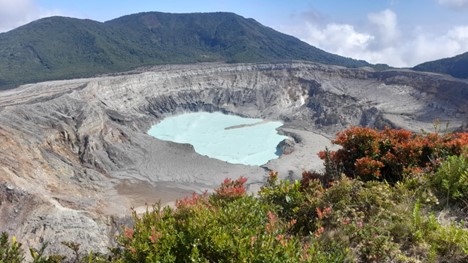
Today we welcomed 10 adventurous women into the Green Edventures family! Participants arrived to San Juan International (SJO) airport yesterday and today and were shuttled to Adventure Inn in Alajuela to begin our Costa Rica Women’s Adventure Wild & Off-the-Beaten Path Osa Peninsula. The Inn has carvings and beautiful murals throughout the property. Early arrivals went on a pre-tour day trip to Poas Volcano National Park, La Paz Waterfall Gardens and Doka Coffee Plantation.
Poas Volcano National Park has one of the largest craters in the world and is located in the forests of Central Mountain Range, which boasts magnificent natural landscapes. This area called “botos” by the Spaniards, referring to a group of Indians who populated the foothills at Northside of the volcano. The term Póas can be derived from the Latin name “quills / púas” due to the presence of some spiny plants in the area or by the existence of a town called “Púas” located near the massif (a compact group of mountains).
The ladies then explored the La Paz Waterfall Gardens Nature Park which is the home of Five Famous Waterfalls and the largest animal sanctuary in Costa Rica. The property is nestled between Poas Volcano National Park and Braulio Carrillo National Park on the eco-route between San Jose and Arenal. Participants got to learn about and see many of the plants and animals they will see in the wild during their tour of Costa Rica including monkeys, butterflies, fungi and orchids.
To close out the pre-tour day participants visited the Doka Coffee Plantation where they got to sip coffee for a much-needed caffeine boost! The ladies learned about the step-by-step process of seed germination to the first crop of plants. They learned about the development process of the plant up to the point of recollection of the ripe grain. They were also told about the history of the estate, its owners, the production and varieties of plants, and the geography of the area and the traditional ways of cultivating the grain.
After their pre-tour activities our entire group got together at our introductory meeting where we discussed the upcoming week of adventures and introduced ourselves. We got to know one another over a nice meal and chatted about the upcoming adventure. It wasn’t a late night because we have an early flight from San Juan to Puerto Jimenez tomorrow.
Birds list from Waterfall Gardens:
Green-crowned Brilliant
Black-bellied Hummingbird
Spotted Barbtail
Costa Rican Warbler
Chestnut-capped Brushfinch
Blue Grossbeak
Palm Tanager
• 03/07/23 Saladero Eco Lodge, Golfito, Costa Rica •
Flight to Puerto Jimenez & Dolphin Tour & Snorkeling
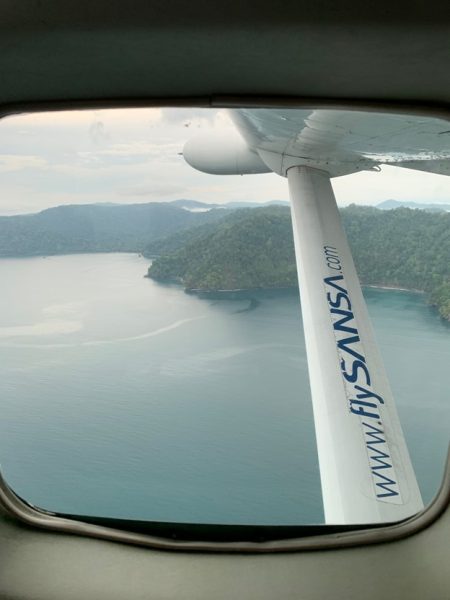
We departed San Juan via SANSA airlines for our scenic flight to Puerto Jimenez in the very early morning. This flight brings us over three different zones of Costa Rica. We begin in the Central Valley Region and fly west to the Pacific Coastal Zone, then south to the Osa Peninsula and Golfo Dulce Area. We see beautiful mountain areas, valleys, and stunning coastal areas on this flight.
We then went on a wildlife hike in Puerto Jimenez where we added many birds to our life list! Some of the species we saw included:
Vultures
Great kiskadee
Great-tailed grackle
Scarlet McCaw
Blue-gray tanager
Streaked flycatcher
Clay-colored thrush
Tropical kingbird
Juvenile tiger heron
White ibis
Tufted flycatcher
Red-crowned woodpecker
Lineated woodpecker
Baltimore oriole
Frigate
We saw a cocoa woodcreeper and learned about its unique tail feathers. The feathers of the tail are rigid and are used for supporting the body when climbing tree trunks. The tail can support most of the body weight and birds that lose their tail find climbing difficult. Woodcreepers climb by flexing their legs and hopping up the trunk. We also learned that the feet of the woodcreepers are also modified for climbing.
We then boarded the Changing Tides tour boat to set out to see and study dolphins. The Golfo Dulce’s calm and very clear jade green-blue water makes it easy to see abundant marine life. Spotted Dolphins are some of the most common dolphins to see. We were lucky enough to be immersed in a pod of over 400! Bottlenose Dolphins stay close to river mouths, using the tidal cycles to catch fish. Golfo Dulce Bottlenose Dolphins are very social and are frequently seen in pods of two to 15 dolphins. We got to see a larger pod of nearly 15 dolphins.
After our dolphin tour and snorkeling at a local conservation reef, we arrived at our first off-grid lodging, Saladero Eco Lodge. We had some cool refreshments and took a walk to learn about the lodge and the plants and trees that grow on site. It was a full but magical day!
• 03/08/23 Saladero Eco Lodge, Golfito, Costa Rica •
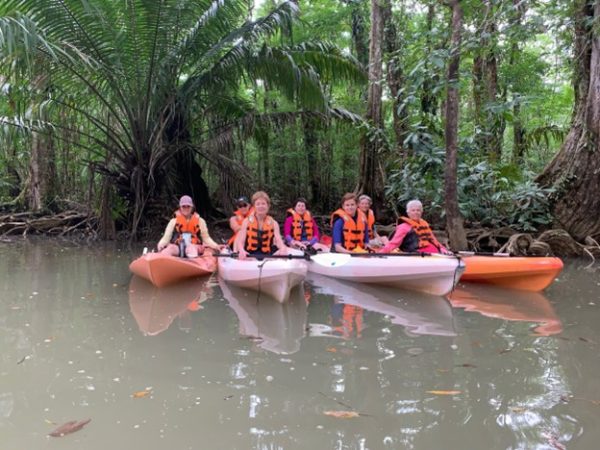
Saladero Ecolodge is surrounded by the Piedras Blancas National Park which has over 30,000 acres of primary and secondary rainforests. We spent the morning on serval trails surrounding Saladero this morning. In the afternoon we split into two groups, group one went kayaking with myself, and group two went hiking with our guide Pepe.
On the hiking trails we learned about leaf cutter ants and their symbiotic relationship with fungus. Using leaves cut from trees, the ants cultivate a fungus from which they feed. Studies show that leaf-cutting ants have been cultivating the same strain of fungus for at least 23 million years. Neither the ants nor the fungus can survive without the other, and this link is perhaps the best recognized example of mutual symbiosis, the dependance of two species on each another. Female leaf-cutters also carry a small patch on their cuticle that grows the bacteria Streptomyces. The ants spread this bacteria over leaves and fungi in the garden to kill other types of fungi. Not only does this particular bacteria ward off parasitic fungi for the leaf-cutters, but it also is found in more than half of the antibiotics in modern medicine today. It was an important lesson on why we need to protect the biodiversity of the rainforest and other ecosystems.
One of the highlights of the Golfo Dulce in Costa Rica is kayaking the spectacular mangroves of the Esquinas river. Golfo Dulce means “sweet water” because there are so many freshwater rivers that feed it. The Esquinas river is a special area between the fresh and salt water. This area is home to 5 species of mangrove trees! The trees occur in “layers” depending on the salinity of the water. The mangroves here are very old and have adapted to the harsh saltwater habitat. We learned about the importance of the mangroves that support a wide variety of wildlife, both above and below their intricate root systems. They also serve as a buffer to reduce erosion from harsh tropical storms and hurricanes.
We added several animals to our life list today, including the black throated trogan, anole lizard, white face capuchin monkey, ringed kingfisher, snowy egret, white ibis, osprey, and little blue heron,
• 03/09/23 Saladero Eco Lodge, Golfito, Costa Rica •

Today on our Costa Rica Women’s Adventure Wild & Off-the-Beaten Path Osa Peninsula, we began the day on trail with Pepe where he taught us about the relationships between figs and wasps. Each fig tree is pollinated by a wasp that is specific to that tree. The fig flower emits a scent that attracts females of that particular wasp species.The wasp crawls into the fig flower through a small hole. The hole is so small the wasp often loses their wings and antenna in the process. The wasp then pollinates the flowers in the process of crawling around the flowers and lays its eggs in the soon to be seeds. This pollen will allow all seeds to grow, not just the ones where the wasp has deposited eggs. The female wasp dies within the fig. The eggs become larvae that grow inside the seeds and emerge after a couple weeks. The males emerge first and start looking for females to mate with. They are smaller than the females and are wingless. After mating they die inside the fig. When the females emerge they are already fertilized and ready to find another fig in which to lay their eggs. At this point, the male flowers inside the fig are ripe and loaded with pollen. Before abandoning their home the females will remember to take a supply of such pollen to carry to the next fig. It’s an amazing process!
It wasn’t long and we were in the middle of a mixed species flock of birds. Mixed-species flocks are temporary communities consisting of multiple species of birds. By flocking together, birds in these flocks increase their foraging efficiency and predator vigilance. These flocks are very social and tolerant, and they don’t compete for the food. In this flock they waited for the Greenlet to tell them what to do. The social flock helps them have access to an area where there are territorial birds because there is safety in numbers. These birds can speak many languages and start to understand each other. Everyone loved this experience so much!
In the afternoon the second group of kayakers enjoyed the mangrove tour and the others hiked the trails surrounding Saladero.
Mangrove tour:
Snowy egret
Great blue heron
Little blue heron
Kingfisher (2 species)
Wimbrell
Willett
Northern rough winged swallow
Osprey
Boat billed heron
Kite
Ibis
Crocodile
Capuchin
Iguana
Crabs
Trails: Gray-capped Flycatcher
Great Kiskadee
Scarlet Macaw
Bright-rumped Attila
Great Curasaw
Crested Guan
Orange-chinned Parakeet
Common Tody Flycatcher
Yellow-throated Toucan
Fiery-billed Araçari
Roadside Hawk
Long-tailed Hermit
Scarlet-rumped Tanager
Palm Tanager
Willet
Laughing Gull
Spotted Sandpiper
Red Lored Parrot
Masked Tityra
Black-crowned Tityra
Chestnut-sided Warbler
Golden-naped Woodpecker
Yellow-headed Caracara
• 03/10/2023 Depart Saladero – Beach Hike to La Leona Lodge •

Today we departed Saladero Eco Lodge and took a water taxi back to Puerto Jimenez. We then took a scenic drive from Puerto Jimenez to Carate. Participants got to see the change in habitats from the calm waters of the Golfo Dulce to the more turbulent Pacific Ocean. We made a pit stop midway to have fresh smoothies and ice cream. While we were stopped Pepe found a sloth in a tree near the restaurant and gave us a quick sloth lesson. Sloths are an amazing walking ecosystem!
Sloths have a special, symbiotic relationship with green algae for the purpose of supplementing their diet. In return, the green algae benefits from shelter and water since the sloth’s fur is extremely good at absorbing and retaining water. The algae-covered fur is also believed to work as a camouflage to avoid predation. Sloths are often hunted by predators such as harpy eagles, ocelots, and jaguars, who mainly rely on movement to track their prey. So, the algae-covered fur and motionless hanging, help sloths blend with their surroundings, making it very challenging to detect them in the wild.
Sloths are also home to a variety of interesting creatures, including the sloth moth. Sloth moths are small, brown moths that live on the fur of sloths. These moths are not parasitic, but they do benefit from the sloth’s slow movements. The moths use the sloth as a means of transportation, moving from one area of the sloth’s fur to another to feed on the sloth’s dried feces. While the relationship between the sloth and the moth may seem odd, it is actually a beneficial one for both species. The sloth provides the moth with a safe place to live and a food source, while the moth helps to keep the sloth’s fur clean and free of parasites.
At the end of the road in Carate we hike 2 miles to LaLeona Eco Lodge along the rainforest and Pacific Ocean. We stopped and learned about the strangler fig tree and watched bats that Pepe put in the scope.
Figs are one of the most important plant species of a rainforest ecosystem. There are close to 1,000 different species of Ficus, which can be found in every major rainforest, tropical continent and islands around the world. Hundreds of animals like pigeons, parrots, hornbills, toucans, monkeys, gibbons, and fruit-eating bats, feed on the sweet fruit of the fig tree.
Figs are considered a “keystone” species because they are so important to the animals of the rainforest. This is because figs bear fruit several times a year. Different species of figs fruit at different times so that there is always a supply of food for animals that depend on fruit as a major part of their diet. A large variety of herbivores and omnivores eat figs. In some forests up to 70% of its animal’s diets depend on figs, and the number of fruit-eaters determines the number of predators of fruit-eaters.
We enjoyed a cool drink and explored the beach when we arrived at LaLeona Eco Lodge. The sunsets here are second to none, absolutely breathtaking.
Our bird list for today included:
Northern Waterthrush
Bare-throated Tiger Heron
Ruddy Ground Dove
Red-legged Honeycreeper
Clay-colored Thrush
Scarlet Macaw
House Wren
Scarlet-rumped Tanager
Bay-headed Tanager
Palm Tanager
Blue and Gray Tanager
Tropical Kingbird
Bananaquit
Rufous-tailed Hummingbird
Blue-throated Goldentail
White-necked Jacobin
Violet-headed Hummingbird
Spotted Sandpiper
Black Vulture
• 03/11/2023 Monkey Camp Hike & Coconut Oil Making Class •
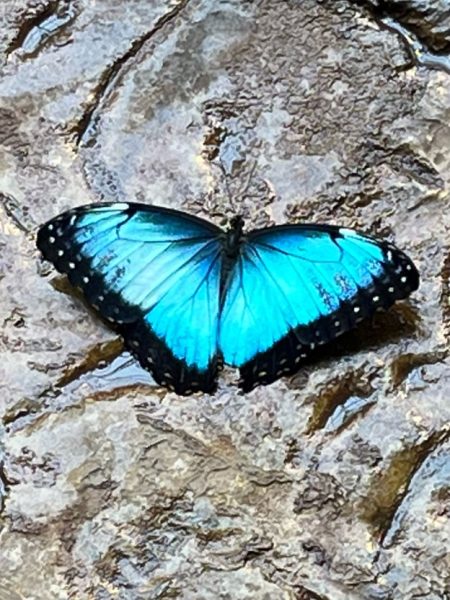
We are doing our most challenging hike of the trip today, called the Monkey Camp Home. We travel from the secondary rainforest surrounding the lodge into the primary rainforest of Corcovado National Park. Simply put, a primary forest is an untouched forest, most often within the context of logging activities, which should have never taken place in that forest area, whereas a secondary forest is a forest that has already been logged or disturbed in a significant way, by the activities of human beings.
It has been raining almost daily and we got to see more amphibians than usual. We almost immediately saw a green and black poison dart frog. Poison dart frogs get their toxicity from some of the insects they eat. The insects feed on plants that have toxins, and those toxins build up within the frog. These frogs are most active after rainstorms and communicate via buzzing vocalizations. Males are territorial and during the breeding season, females often compete for access to males. Poison Dart Frogs are insectivores and in their native habitat, they specialize in eating certain poisonous ant species from which their bodies’ own poison is derived.
There were also several blue morpho butterflies fluttering around the trails today. Morpho butterflies live mostly in the tropics. When resting, they fold their wings up, showing their dark earth-toned undersides. The brown, yellow and black colors are generated by pigments. But the other side is all about structural color. It gives their wings a vibrant, iridescent blue hue. Each scale is like a pixel, a tiny tile in a larger mosaic in layers of overlapping rows. Pigments are different from structural colours. Pigments look the same from all angles. Structural color is the result of reflection or iridescence. Structular colour means that certain creatures appear from different angles to have different colours. For example, the wings of a butterfly look different from some angles compared to others.
We also learned more about the strangler fig trees today and how they compete for light and nutrients in the rainforest. Strangler figs are tall canopy trees which can grow to 148 feet in height. The manner in which they reach the canopy is really interesting. The forest floor of a rainforest is a difficult place for seedlings to grow. There is little light and a lot of competition for water and nutrients. Strangler figs have made an adaptation to avoid these difficulties. Unlike most plants, strangler figs start out their lives as epiphytes in the crook of a tree or on its branches. Tiny, sticky seeds are deposited high in a tree by animal droppings. The seeds are not affected by the animal’s digestive tract and soon germinate. The strangler fig has an aggressive growth habit that insures its survival in the rainforest. The seedlings grows slowly at first, getting their nutrients from the sun, rain and leaf litter that has collected on the host. The stranglers send out many thin roots that snake down the trunk of the host tree or dangle as aerial roots from its branches. When the roots reach the ground, they dig in and put on a growth spurt, competing with the host tree for water and nutrients. They also send out a network of roots that encircle the host tree and fuse together. As the roots grow thicker, they squeeze the trunk of its host and cut off its flow of nutrients.
Our bird species list today includes:
Scarlet Macaw
Northern Waterthrush
Amazon Kingfisher
Bare-throated Tiger Heron
Red-legged Honeycreeper
Riverside Wren
Chestnut-backed Antbird
Black-hooded Antshrike
Bananaquit
Rufous-tailed Hummingbird
Blue-throated Goldentail
Scarlet-rumped Tanager
Blue and Gray Tanager
Black Vulture
Spotted Sandpiper
Ruddy Ground Dove
White-tipped Dove
Brown Pelican
Red-crowned Woodpecker
If you are looking for a Women’s Adventure in Costa Rica, CLICK HERE to view all the details and itinerary for this trip, we would love to have you join us!
• 03/12/2023 Puerto Jimenez, Costa Rica •
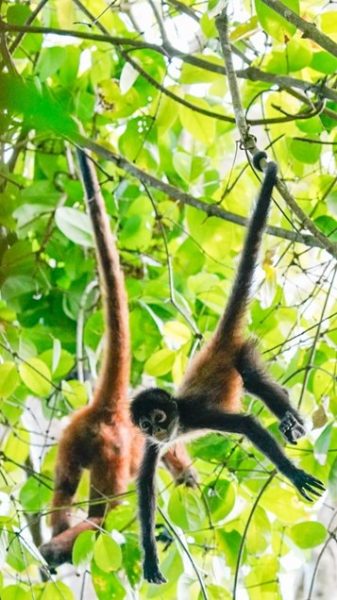
Hike to Carate – Transfer to Puerto Jimenez – Cacao Farm Tour -Women’s Co-Op – Cabinas Jimenez
We hiked from LaLeona Eco Lodge back to Carate today, then took the taxis to Puerto Jimenez. We came across a large cicada and Pepe explained how they make their loud noise that is almost constantly heard on hot days. Male cicadas have sound boxes in their abdomens. They make their sound by expanding and contracting a membrane called a tymbal. They use their sound to attract females, which make clicking noises when they are ready to mate. The hotter the day, the louder the male cicadas make their sounds. Male cicadas make several types of sounds including a mating call, a distress call, an encounter call (or celebration call) which is made after the female agrees to mate and a call to signal they want to be alone.Cicadas usually sing during the heat of the day. In addition to attracting a mate, the loud noise actually repels birds. The cicada’s song is painful to the birds’ ears and interferes with their communication, making it difficult for the birds to hunt in groups. Male cicadas in the same brood will stick together when calling in order to increase the total volume of noise. This reduces the chances of bird predation for the whole brood.
We also got to see a group of spider monkeys swing around and eat in the canopy right above us. They are so comical to watch! Spider monkeys have long, thin arms with hooklike hands that allow them to swing through the trees. They do not have opposable thumbs. The spider monkey has a prehensile tail, which means it can grasp and can be used like a fifth limb to grab trees. During the day, the spider monkey searches for fruit, which makes up the main part of its diet. They will also eat flowers, seeds, bark, leaves, and small insects during the dry season when fruit isn’t available. They spend most of the daylight hours climbing and swinging through the high canopy of trees.
When we arrived in Puerto Jimenez we learned all about chocolate at the Osa Cacao Chocolate Factory. We were welcomed with a delicious hot chocolate drink. Participants learned about the entire chocolate manufacturing process and made their own chocolate bar. The smell of the chocolate was absolutely intoxicating! This family operation does everything from planting the trees and maintaining them, harvesting, fermenting, drying, seed roasting and finally grinding and making chocolate products. We also got a chocolate facial, shea butter moisturizer and tropical fruit with chocolate spread treat.
Today’s birdlist:
Clay-colored Thrush
Scarlet-rumped Tanager
Baltimore Oriole
Red-crowned Woodpecker
Turkey Vulture
Black Vulture
Scarlet Macaw
Ruddy-Ground Dove
Red-Lored Parrot
Orange-chinned Parakeet
Boat-billed Flycatcher
Social Flycatcher
Great Kiskadee
Streaked Flycatcher
Variable Seedeater
Brown Pelican
Magnificent Frigatebird
Great Egret
• 03/13/23 Puerto Jimenez to San Jose, Costa Rica •
Zipline Canopy Tour – Flight to San Jose
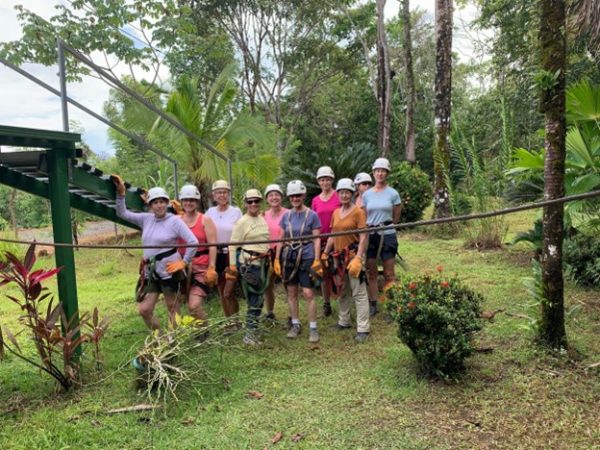
We got to fly through the rainforest canopy like a scarlet macaw today! We started our day with a zipline tour. It’s always fun to change perspectives and see the rainforest from the canopy. We spent most of our week looking up to the activity in the rainforest canopy, but today we got to fly through the canopy and experience the life up there. We were treated with a troop of spider monkeys swinging right past one of our platforms ash’s got to watch them up close. We also learned about rubber trees and vanilla orchids. The zipline company farms vanilla from orchids along the trails of the zipline and near the base camp.
Vanilla comes from the largest family of flowering plants, the orchids, as well it is the only orchid that produces pods. Every stage of vanilla bean production needs to be completed by hand, making it one of the world’s most labor-intensive crops.
We usually get a very scenic flight from Puerto Jimenez to San Jose, but today’s weather was rainy and very cloudy. The weather changes pretty drastically flying from the Osa Peninsula where it’s usually hot and humid into the cooler Central Valley.
The Central Valley is a plateau and a geographic region of central Costa Rica. The land in the valley is a relative plain, despite being surrounded by several mountains and volcanoes, the latter part of the Central Range. The region houses almost three quarters of Costa Ricans, and includes the capital and most populous city, San Jose where we lagged today. The valley is shared among the provinces of Alajuela, Heredia, San José and Cartago. The region occupies an area of 11,366 km², more than a fifth of the country, and is drained by the Tárcoles River on the west side and by the Reventazón River on the east side.
We took a short van tour around Alajuela on our way to Adventure Inn where we stayed the night. On the tour we got to see a huge bronze statue of Juan Santamaria in the by Juan Santamaria de Alajuela Park in his hometown, Alajuela ash’s learn about his story.
Juan Santamaria was a young Costa Rican solider who died at the age of 25 at the Second Battle of Rivas, which took place on April 11, 1856 in the Nicaraguan town of Rivas. During the battle, opposing army’s men were cornered near a hostel. The Costa Rican army attempted several times to set fire to the hostel but failed. Juan Santamaria was the last one to attempt to set the hostel on fire and succeeded, eventually causing the men to retreat. He ended up dying from the fire and was made into a national hero in Costa Rica.
After the tour we ate our final meal together in Moon Glow restaurant where our adventure all began. The evening was full of laughter and stories of our trip together. Pepe and I said our goodbyes and thanked this incredible group of ladies for coming on this trip with Green Edventures. We came in as strangers and everyone flew home with a large new group of amazing friends.
If a trip to Costa Rica is on your bucket list, please join our Facebook Costa Rica Interest Group, and receive updates and information on dates for next year.
Click here for details and trip highlights for our Costa Rica Trip.
To join our email list to find out about all our trips click here.

